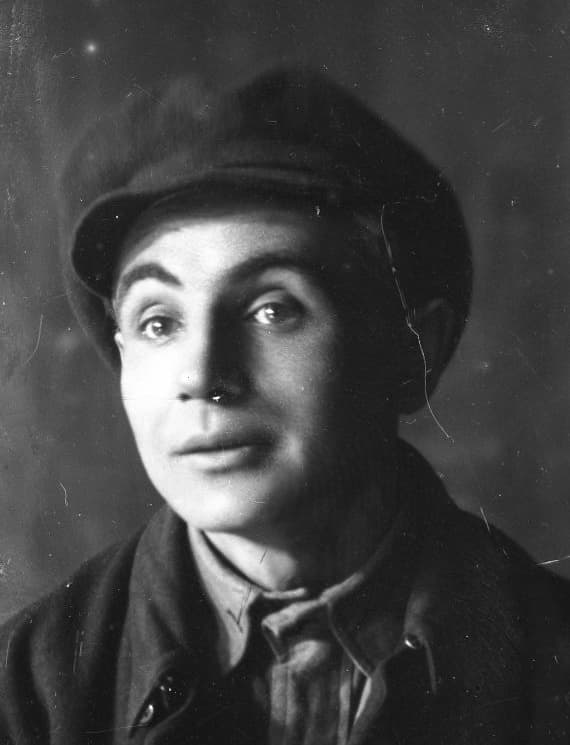Revue in 2 parts
Text: Yu. Vukhnal and P. Petrov-Sokolovskyi (text of premiere by Kostia Burevii)
Premiere: April 14, 1931
Adaptation: Borys Balaban and Volodymyr Skliarenko
Set Design and Costumes: Vadym Meller
Music: Yulii Meitus
Dances: Borys Balaban and Ervina Kupferova
Director: Borys Drobynskyi
Member of Director’s Lab: V. Voronov
Scenes: Zmiivska Street, Garden of Culture and Recreation, Red Army Camp, Peace Branch, Dynamo, and others
Cast: Yosyp Hirniak, Marian Krushelnytskyi, Borys Balaban, L. Balaban, Yevhen Bondarenko, О.
Vereshchynska, Zhadanivska, Tarama Zhevchenko, Yaroslava Kosakivna, Kostiucheko, Lidiia Krynytska, Kudlai,
Hanna Lor, Andri Makarenko, Mykola Nazarchuk, Pavlovskyi, Yevheniia Petrova, Yevhen Ponomarenko, Klavdiia
Pilinska, Fedir Radchuk, Oleksandr Romanenko, Mykola Savchenko Yuliia Fomina, Frantsman,
Oleksandr Khvylia, Khodkevych, Oleksandr Yailo
The revue Four Chamberlains was first performed on the Berezil stage on April 14, 1931 and was an organic continuation of the revue Hello, This is Radio 477 (premiered on January 9, 1929). The young directors of Hello – Borys Balaban, Kuzma Dikhtiarenko, Leontii Dubovyk and Volodymyr Skliarenko – wanted to create a multi-genre show with elements of buffoonery, pantomime and verses that would promote the creation in Ukraine of theaters of “light” genres: satires, operettas, variety shows. The revue as a genre first appeared on the Berezil stage, although there were elements of it in Riff-Raff (1926). Trying out the entertainment genre was part of the Berezil theater’s repertoire policy. Kurbas wanted to stage shows that were relevant to the European scene. This also applied to the revue genre. Kurbas was in Germany in 1927 and expressed his thoughts in “About foreign theatrical life” . In addition to shows by Max Reinhardt, Erwin Piscator and others, the director also attended performances at the Paris Revue Theater, which sparked his interest and desire to stage something similar on his own stage.
In early January 1919, Les Kurbas wrote about the upcoming premiere of Hello, This is Radio 477 in the newspaper Visti VUTsVK (News of the All-Ukrainian Central Executive Committee): “For the first time a Ukrainian chastushka [humorous folk song] in the form of kolomyikas is presented with the hope that they will become a type of Ukrainian variety show. In the revue there is a special type of conferencier, where, breaking with conventions, the theater depicts symbolic masks of two nice strolling students instead of the commoner that was always depicted by the conferencier
That’s why the Kharkiv audience met the student conferencier duet of Liashch and Svynka (the joint project of directors Volodymyr Skliarenko and Borys Bababan) for the second time in the revenue Four Chamberlains. Unlike Hello, This is Radio 477, The Four Chamberlains wasn’t very successfully. That’s probably why there weren’t many reviews about it in the press. For example, Valerian Revutskyi had this to say about the acting: “In the show, Hirniak appears in the leading role (together with M. Krushelnytskyi) as student Liashch, who we remember from the previous revue Hello, This is Radio 477. This time he and his partner Svynka wore tailcoats and commented on everyday life, sometimes in the form of songs or kolomyikas about economic (criticism of Ukrtiutiuntrest or Krymtabaktrest) and literary issues (criticism of neoclassicists or futurists), and also ridiculed international topics related to the name Chamberlain (Liashch and Svynka even write him a letter – a parody of the famous letter written by the Zaporozhzhian Cossacks to the Turkish sultan), Poincaré, Piłsudski, and others. Liashch and Svynka also played detectives who are hunting the four Chamberlains and finally find them”
This revue was harshly criticized by Dmytro Hrudyn, who said that Hirniak and Krushelnytskyi were hostages to poor-quality literary material: “The play The Four Chamberlains, albeit in a very different form, repeats the same hostile concepts that were pronounced and carefully framed in The People’s Malakhii. Here we have the same opposition Trotskyites veiled in obscenity and ‘jokes,’ ‘repetition of the backsides’ of the blessed memory of the spirit of VAPLITE, Khvyliovyi and Malakhii. Berezil’s The Four Chamberlains is another ‘ruse’ subtly designed for the worst tastes of the backward spectator, to ‘take’ this spectator at any price […] This whole play is held together by two talented artists, who you just feel sorry for”. Obviously, D. Hrudyna was more concerned about the ideological focus of The Four Chamberlains than analyzing Berezil’s creative work. According to Oksana Burevii-Yatsenko’s memoirs, he had another personal reason to criticize the show. Her father, Kost Burevii, likened the critic to one of the characters in the revue – comrade Svynyna, the theater expert who uttered all sorts of nonsense. However, whatever the critic’s reasons for writing the pasquil, it should be noted that the satirical verses by Liashch and Svynka that Hrudyna quoted in his article were in fact quite unbalanced and illogical.
The most comprehensive memories about this show are in a letter by Kost Burevii’s daughter. Oksana Burevii-Yatsenko writes that the revue based on her father’s text was performed more than 100 times and was popular. During the tour, the train car with the scenery caught fire and it could not be replaced. After Burevii was executed, his name was removed from the posters and the show was performed using someone else’s text in the ‘hurray for communism’ spirit. This is likely the reason for the decline of its artistic value and the subsequent criticism in the press. Nevertheless, The Four Chamberlains became an important formative link in the chain of the stylistic achievements by Berezil.

